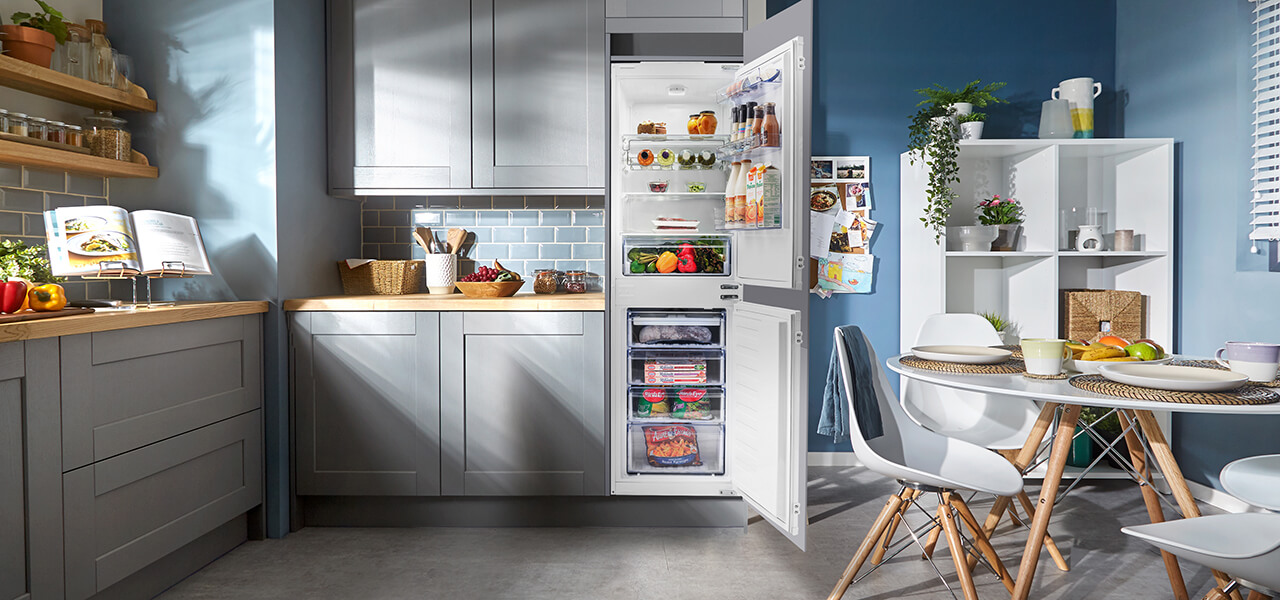What temperature should a fridge freezer be?
Maintaining the correct temperature in your fridge freezer is essential for preserving food freshness and quality over time. It ensures that your groceries stay fresh for longer by slowing down the growth of bacteria and microorganisms. To help you understand the importance of maintaining optimal temperatures in your fridge freezer, we have created this helpful guide.

Why your fridge freezer's temperature matters?
Keeping your fridge freezer at the correct temperature is essential for ensuring food safety and extending the longevity of your groceries. In the refrigerator compartment, maintaining temperatures between 3°C to 5°C effectively slows down bacterial growth, preserving perishable items and reducing the likelihood of foodborne illnesses. This optimal range also helps retain the nutritional value and taste of foods, ensuring they remain safe to consume over extended periods.
In the freezer compartment, temperatures should ideally be set at -18°C or lower to halt the growth of bacteria and microorganisms. This process not only preserves the quality of frozen foods but also supports their long-term storage without compromising taste or texture. Setting temperatures too low can lead to unnecessary energy consumption and increased utility costs, while inadequate temperatures may fail to adequately preserve food, resulting in wastage and potential health risks. Therefore, regular monitoring and adjustment of your fridge freezer's temperature settings are crucial for maintaining optimal performance, maximising food freshness, and promoting efficient energy use.
What temperature should a fridge freezer be?
Many people are unaware of the correct temperatures for a fridge and freezer. It is important to understand these optimal settings to ensure your food stays fresh and safe. For the fridge compartment, we recommend maintaining a temperature between 3°C to 5°C to slow bacterial growth and preserve perishable items effectively. Similarly, for the freezer compartment, it is best to set the temperature at -18°C or lower to freeze food solid and maintain its quality over longer periods.
How do you check the temperature of your fridge?
To check the temperature inside your fridge, we suggest you place a thermometer inside a glass of water and leave it on the middle shelf for 12 hours or overnight. This will allow the appliance to cool the contents to the right temperature and provide an accurate reading of the temperature inside. Some models may display the temperature externally on the door. However, this is the set temperature, not the actual temperature of your fridge. If you ever have doubts, please follow the above steps. Alternatively, please contact Beko’s expert Customer Care team at 0333 207 9710 for assistance.
How do you check the temperature of your freezer?
To check the temperature of your freezer, place a thermometer in the centre of the freezer compartment and allow it to stabilise for several hours to obtain an accurate reading. Ideally, the freezer temperature should be maintained at -18°C or lower to effectively preserve frozen foods. Regularly monitoring the freezer temperature ensures that it remains within this optimal range, providing assurance that your frozen items are stored safely and maintaining their quality over time.
Top tips for maintaining safe fridge freezer temperatures:
- Keep your fridge freezer door closed as much as possible. To keep your fridge freezer working at an optimal temperature, it is important to ensure hot air is not entering the appliance regularly. The build-up of frost inside a fridge/freezer is caused by an interaction between warm and cold air. To prevent ice build-up, make sure that you do not leave your fridge door open for extended periods. Equally, check your appliance’s door seals to ensure they are not damaged or affecting your fridge’s temperature. If they are cracked or raised, we recommend contacting our Customer Care team at 0333 207 9710.
- Only put food in the fridge freezer once it has cooled completely. Similar to the above, it is important not to put hot food inside your fridge or freezer. This will dramatically increase your appliance’s internal temperature, meaning your food will be stored at the wrong temperature. Instead, make sure all food has cooled completely before storing it in your fridge freezer.
- Don’t overpack your fridge freezer. When stocking up your fridge freezer, ensure you are not overpacking the appliance. It is important to leave enough room for air to circulate around the appliance’s interior. If your fridge or freezer is crammed with groceries, cold air will not be able to circulate fully, meaning temperatures will vary and bacteria could grow.
What is the recommended ambient temperature a fridge freezer should operate within?
Beko larder fridges and static fridge freezers should ideally placed in environments with temperatures of 5 degrees Celsius and above. However, Beko freezers and most frost-free fridge freezers can function in ambient temperatures as low as -15 degrees Celsius. It is advisable to use only the freezer compartment in such low ambient temperatures and avoid using the fridge compartment.
If you need an appliance for storing items in colder environments like a garage or outbuilding, consider our range of Fridge Freezers for garages, ensuring reliable operation in varying temperatures.
How do I change my fridge or fridge freezer's temperature?
It is important to know how to change the temperature in your Beko fridge or fridge freezer. By adjusting your appliance to the optimal temperature, you can ensure that your food is kept fresh and hygienic. The process of changing the temperature of your appliance varies depending on the model you own. To find out how to adjust the temperature on your specific appliance, please click here. For a visual guide, please watch the video below.

To provide a general overview, we’ve put together a handy how-to guide to help you change the temperature in your fridge freezer. To help you understand the way our temperatures work, here’s a helpful chart that shows what each temperature setting on your fridge means:
| Dial Display | Temperature Setting |
|---|---|
| 0 | Cooling system off |
| Minimum or 1 | Warmest setting |
| 2 to 4 | Recommended setting |
| Maxiumum or 5 | Coolest setting |
Now that you have all the information you need about fridge temperatures, why not browse our full range of fridges and fridge freezers? Or, if you are looking for information relating to your freezer’s temperature, check out our handy freezer temperature guide.
Need Product Support?
If you have any questions about your Beko fridge, we are here to help. For more information, including detailed video guides, explore our dedicated refrigeration how-to guide. We do not recommend that you try to repair the appliance yourself. If you are experiencing issues with your fridge, please contact Beko’s Customer Care at 0333 207 9710 for assistance. Our expert support team will be more than happy to assist and organise technical assistance for you.
Did we answer your question?
We are so sorry we were unable to answer your question. You might be able to find the answer you are looking for in the ‘Related Questions’ below. If your query is still unanswered, please head over to our Contact Us page for further assistance.
Search FAQ’s
Search or browse our frequently asked questions to find the answer to your query.




